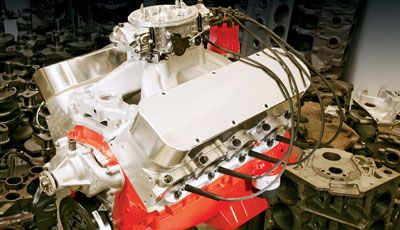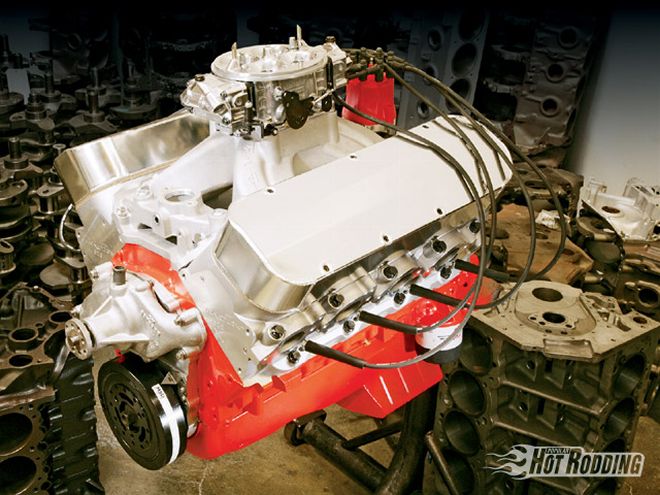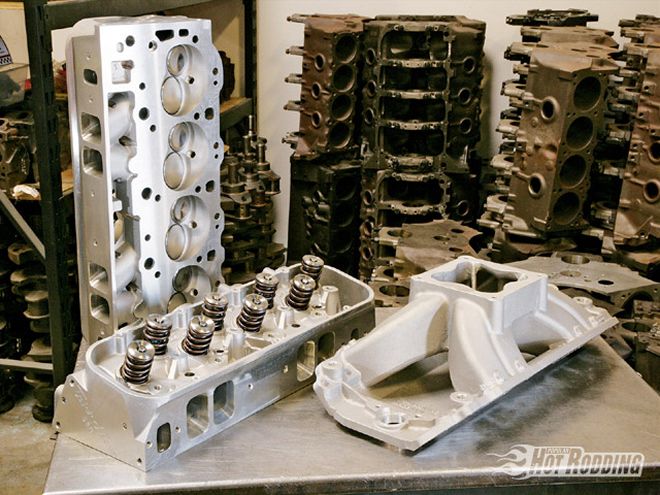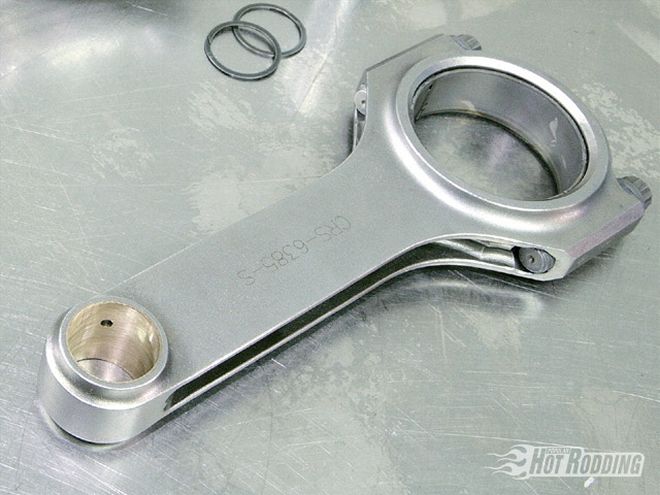

A pile driver is a mechanical device that smashes the earth with tremendous force, and the term is a fitting description of this 509ci street big-block Chevrolet unleashed by Outlaw Racing's Andy Mitchell. As our story goes, we had a 502 Chevy Ramjet engine liberated from Popular Hot Rodding's Project X, a fine engine combination from General Motors, replaced by an all-aluminum 427 in the latest incarnation of our heroic project car. We found ourselves in the enviable situation of having Project X completely renovated by the crew at GM with an all-new mill, while the old engine was hanging from a hook waiting for whatever our collective imaginations might conjure.
A 502 Chevrolet is not your standard production big-block, and its most distinguishing characteristic is the over-sized 4.470-inch bore. Production big-blocks were a full .220-inch less endowed in terms of bore size, and that big bore definitely provides an edge. A big bore provides a substantial displacement without the necessity of ungainly stroke increases. The formula here equals big cubes at moderate piston speeds, with less bore shrouding of the airflow into the engine. A big bore produces lower reciprocating assembly loads at high rpm than a similarly sized combination based upon a production block with its smaller bore. The block represented a substantial opportunity to unleash tremendous force, a potential that was just mildly exploited in the engine's original form. Our plans were to use the big-bore 502 block to build a high-powered street combination, a combination that could be accomplished with minimal effort.
 We had big goals for the Pile Driver big-block: top 700 hp on pump gas, and do it with off-the-shelf parts. The only way to get there while staying naturally aspirated is with a solid roller cam, and deep-breathing induction components. Our search for the right heads and intake lead us to Trick Flow Specialties new PowerPort cyinder heads and R-Series single-plane intake.
We had big goals for the Pile Driver big-block: top 700 hp on pump gas, and do it with off-the-shelf parts. The only way to get there while staying naturally aspirated is with a solid roller cam, and deep-breathing induction components. Our search for the right heads and intake lead us to Trick Flow Specialties new PowerPort cyinder heads and R-Series single-plane intake.
With a 4.470-inch bore and a 4.00-inch stroke, a Chevrolet 502 is a big-bore combination relative to the stroke. It is an arrangement that is naturally suited to make strong power at higher rpm, and do so reliably, given the correct parts. In its original form, the Ramjet was configured to make tremendous torque in a mild engine combination. With conservative cam timing, moderate cylinder heads, a long-runner injected intake manifold, and a mild compression ratio, the engine produced low and midrange torque in abundance, with a peak of 565 lb-ft at a very low 3,200 rpm, along with its rated peak horsepower of 502 at 5,100 rpm. As much as we appreciate low-end torque, we had to wonder just what that big-bore engine could do if built to run up the rpm range.
Build Plan
Our strategy to tap into the higher rpm potential of the 502 involved nothing but the basics, using readily available aftermarket parts to add some heat to the combination. Sure, we would lose the dead-smooth idle quality of the original engine, but for a hot street machine it was a worthy trade for massive power gains through the mid and upper rpm range. The key areas of attention were the cylinder heads, cam, valvetrain, induction, and compression ratio. These are the parts that really determine the character of the engine. While the OEM combination was designed to produce a high vacuum, a dead-smooth idle, and a low-rpm torque, our new parts list was intended to produce serous power in the street/strip rpm range up to 6,500 rpm.
TFS Heads and Induction
Taking center stage in our upgrade were the new Trick Flow PowerPort heads for the big-block Chevrolet. These 320cc rectangular-port cylinder heads feature a 2.25/1.88-inch valve combination, 121cc chambers, and outstanding flow, with 360-plus cfm available at peak lift. With their ample size and flow, these cylinder heads are aimed squarely at the high-performance street and street/strip market, representing a substantial increase in capacity in comparison to the original oval-port Bow Tie GM heads, which are targeted more toward low-end torque.
 We planned on building this engine to a much higher rpm potential than that of the original 502 Ramjet engine, so the factory I-beam rods were replaced with Eagle 4340 forged H-beams.
We planned on building this engine to a much higher rpm potential than that of the original 502 Ramjet engine, so the factory I-beam rods were replaced with Eagle 4340 forged H-beams.
The Trick Flow heads come assembled with the supporting equipment required to go the distance in a high- performance engine with bronze valve guides and interlocking ductile iron valve seats. They come fully assembled with valves, springs, 10-degree steel locks, retainers, and Viton fluoroelastomer seals. Guideplates for 3/8-inch pushrods and 7/16-inch rocker studs are included. In view of our intended camshaft selection, our heads were assembled with solid-roller-spec Isky 9385 tool room springs. These springs measure 229 pounds closed (2.000 installed height) and 542 pounds open (at .650-inch lift, 1.350 height), which puts the spring loads right where we wanted for a moderate solid roller.
With the change to a rectangular port head, we naturally had to consider the induction system. Besides the obvious oval-to-rectangular port mismatch, the Ramjet induction is geared toward low-end torque, and presents complications when combined with more radical cam timing of the level we were considering. For our application, a single four-barrel induction was the logical solution, and is more representative of the typical style of induction an enthusiast would select if building a 502/509 combination from scratch. To complement the cylinder heads, the Trick Flow R-Series single-plane intake was the natural choice. This intake is designed for 500-plus cubic-inch big-block Chevys, with high-flowing extended runners and a raised plenum floor beneath its 4500-Series Dominator carb flange. Topped with a brand-new Holley 1150 Ultra Dominator carb (see "Domination!" October 2009), there was little doubt that this induction could support whatever power potential our revised engine combination was capable of.
Cam and Valvetrain
When power is the overriding concern, a solid-roller camshaft is the cam style of choice. Without a hydraulic mechanism and utilizing a roller follower, a solid roller offers the highest load capacity and best high-rpm stability of any camshaft configuration. This allows quick opening action at the valves, with the capability to handle the substantial valvespring loads needed for high-rpm valvetrain control. With our intended hot-street application, we looked no further than COMP's excellent line of street roller profiles and selected a custom-ground roller cam using lobe numbers 4876/4877 on the intake and exhaust, respectively. [For more on this particular valvetrain and how we set it up, check out "How To Set Up A Winning Valvetrain" in the September 2009 issue of PHR.-editor] This combination is stout enough not to be for the faint of heart, with 292/298 degrees of gross duration (at .020-inch tappet rise), 254/260 duration at .050, and .653/.666-inch lift. Our friend and frequent PHR contributor David Vizard spec'd the cam with a tight lobe separation angle of 105 degrees. This helps bring on the massive torque rise in the midrange, taking horsepower production up with it to our intended operating range of approximately 6,500 rpm.
To work along with the COMP solid-roller camshaft, we ordered a set of COMP Endure-X solid-roller lifters, PN 833-16, which have durability features such as direct roller bearing oiling to enhance longevity in a street application. Rounding out the valvetrain are a set of Trick Flow 3/8-inch pushrods operating Crane Gold 1.7:1 rocker arms.
Bolting It Together
With the key elements of our new parts combination in mind, we brought our 502 big-block and the requisite parts to Outlaw Racing for machining and assembly. With the original GM 502 combination, flat-top pistons were employed with the small 110cc chamber oval-port heads for a compression ratio of 9.6:1. With our parts combination aimed at higher rpm and a much more aggressive camshaft, some changes were due for the bottom end. Upgraded pistons was high on that list, since with the larger chambers of the Trick Flow heads, the compression ratio would be far too low with the existing pistons. Since our intent was a fully blueprinted rebuild with a .030-inch overbore, we selected the 17cc-domed SRP pistons, which yield a very pump-gas friendly compression ratio of 10.1:1 with our cylinder heads.
As a further nod to durability, the rods were upgraded to Eagle's bulletproof 4340 forged H-beams in place of the original I-beams. Mitchell bored and honed the block to a 4.500-inch bore size, index-surfaced the block to achieve a zero deck height, balanced the rotating assembly, and then proceeded to final assembly. Far from a complex build, Mitchell relates that the engine was very straightforward to assemble. "We really didn't have any problems with anything," he says. "It actually went together very smoothly. We built it in stages, and put the short-block together first, and then later put the top-end on it. It was pretty pain-free really."
Many of the parts from the original 502 were reused, while new Clevite bearings, Fel-Pro gaskets, and Sealed Power rings made up the basic rebuild components. The camshaft was installed using a COMP timing set, and degreed to a 101-degree intake centerline angle. The cam was entombed by a COMP two-piece aluminum timing cover, which separates the cam cover from the function of sealing the oil pan rail.
Testing Time
As the crew at Outlaw Racing dropped in the new MSD Pro Billet distributor and screwed in a fresh set of Champion C61 spark plugs to complete the final details on our now 509ci big-bore Chevy, we were chomping at the bit to see what this thing would do. It wasn't long before we trucked it to Westech Performance Group and bolted to their SuperFlow 902 dyno for the numbers. With the tight-centered solid-roller cam operating the valves, the dyno cell resonated with the bark of power. The engine moderately loped at the steady idle following the dyno's automated engine break-in cycle. Dyno operator Steve Brule worked through the normal checks and adjustments required of any new engine assembly. Then we drained the crankcase of the Royal Purple 10w30 break-in oil for a fresh load of their standard 10w30 synthetic and installed a new Fram TG-30 filter.
When the hammer was dropped, the engine did not disappoint. The tight-centered solid-roller cam worked in concert with the Trick Flow heads to really feed the beast, tuning in to produce explosive torque as the tach began to swing upward. A peak torque of 651 lb-ft at 5,100 rpm was recorded; that's a very stout number for 509 cubes at just over 10:1 compression and swilling pump gas. It was obvious from the torque reading that we had a very happy combination with this engine, with a gain of 96 lb-ft over the original fuel-injected 502 engine combination. With all that torque came no shortage of horsepower, as the engine pulled eagerly to 6,500 rpm, posting a peak of 717 hp at 6,300 rpm. The reconfigured engine was churning out well over a 200hp gain. With our 509 Chevy's crushing midrange torque and the substantial punch delivered at the top, this engine earned its "Pile Driver" name.
WHERE THE MONEY WENT Description: Source: Part No. Price: GMPP 502 block and crank Project X, take-off 10237292 n/a GMPP 502 4-inch stroke forged crank Project X, take-off 10183723 n/a GMPP 502 6-quart oil pan Project X, take-off n/a n/a GMPP 502 damper Project X, take-off n/a n/a GMPP 502 water pump Project X, take-off n/a n/a GMPP 502 oil pump pick-up Project X, take-off n/a n/a Trick Flow 320cc PowerPort heads Trick Flow/{{{Summit}}} TFS-41400002 $2,095.95 pr. Trick Flow R-series single-plane intake Trick Flow/Summit TFS-41400111 $399.95 Trick Flow valve covers Trick Flow/Summit TFS-41400803 $245.95 Trick Flow pushrods (intake) TFS/Summit, 3/8 inch x 9.550 TFS-21419550-8 $56.95 (set of 8) Trick Flow pushrods (exhaust) TFS/Summit, 3/8 inch x 8.650 TFS-21418650-8 $56.95 (set of 8) {{{Eagle}}} rods, 6.385-inch forged Eagle/Summit ESP-63853D $459.95 set SRP 17cc dome pistons, 4.500 bore SRP/Summit SRP-212147 $538.88 set Sealed Power rings, 1/16, 1/16, 3/16-in. Sealed Power/Summit SLP-R104515 $155.39 Main Bearings Clevite/Summit CLE-MS829H $79.95 Rod bearings Clevite/Summit CLE-CB743HN $87.60 Cam bearings Clevite/Summit CLE-SH616S $26.95 Intake bolt kit ARP/Summit ARP-435-2002 $55.95 Holley Ultra Dominator, 1150-cfm Holley 0-80556-2BK ${{{960}}} Carburetor stud kit Summit SUM-G1421 $3.69 COMP roller cam, 4876B/4877B SR105 COMP Cams 01-000-8 (custom) $303 COMP Endure-X solid roller lifters COMP/Summit CCA-883-16 $489.95 Two-piece Gen VI timing cover COMP/Summit CCA-217 $249.95 Timing set COMP/Summit CCA-3149KT $182.75 Cam bolt kit COMP/Summit CCA-234 $9.95 Balancer bolt kit Summit SUM-G1678 $7.95 Crane Gold 1.7 roller rocker arms Crane/Summit CRN-13750-16 $319.95 Distributor, MSD Pro Billet Summit/MSD MSD-8555-1 $227.95 Ignition wires, MSD Super Conductor Summit/MSD MSD-31299 $75.95 Spark plugs, Champion C61 Summit/Champion CPN-688 ($3.69 each) $29.52 Intake gaskets FelPro/Summit FPP-1275 $16.95 Gasket set FelPro/Summit FEL-KS2618 $58.95 Oil pan gasket set FelPro/Summit FEL-OS34407R $21.95 Expansion plug kit Sealed Power/Summit SLP-381-8009 $14.99 Oil pump Melling/Summit MEL-M77HV $32.95 Oil pump driveshaft Melling/Summit MEL-IS77 $6.63 Oil pump stud ARP/Summit ARP-230-7003 $4.88 Head bolt kit ARP/Summit ARP-135-3607 $83.95 Oil filter adapter AAMidwest OFA305 $9.50 Fram Tough Guard oil filter Rock Auto TG-30 $8.95 Synthetic 10W30 break-in oil Royal Purple/Summit RPO-11487 (6 quarts) $47.70 Engine paint Dupli-Color DE 1607 $5.99 Parts total: $7,434.42 MACHINE WORK (OUTLAW RACING): Clean block: ${{{80}}} Block bore & hone: $245 Cam bearings: $60 Deck resurface: $120 Balancing: $180 Main bearing housing check-out $40 Machine shop labor total: $725 Parts & labor total: $8,159.42 ON THE FLOW BENCH TRICK FLOW 320CC POWERPORT Valve Int. Int. Exh. Exh. Lift: (good): (poor): (ext. pipe): (no pipe): .050 35 35 30 30 .{{{100}}} 73 73 64 64 .150 110 110 102 101 .{{{200}}} 146 145 126 118 .250 188 186 148 140 .{{{300}}} 222 220 167 160 .350 247 246 184 175 .400 279 276 201 188 .450 298 297 218 202 .500 318 315 {{{240}}} 215 .550 336 333 256 225 .{{{600}}} 342 339 267 238 .650 355 350 278 250 .700 359 352 289 258 .750 362 355 296 265 .800 363 356 299 268 {{{DTS}}} DYNO DATA 509CI BIG-BLOCK CHEVY RPM TQ HP 3,400 592 383 3,500 591 394 3,600 594 407 3,700 600 422 3,800 606 439 3,{{{900}}} 610 453 4,000 612 466 4,100 614 479 4,200 617 494 4,300 623 510 4,400 628 526 4,500 634 543 4,600 639 560 4,700 644 576 4,800 647 592 4,900 650 606 5,000 651 620 5,100 651 633 5,200 651 644 5,300 650 655 5,400 648 666 5,500 645 676 5,600 642 684 5,700 638 692 5,800 633 699 5,900 629 707 6,000 623 712 6,100 616 715 6,200 607 717 6,300 598 717 6,400 589 717 6,500 578 715